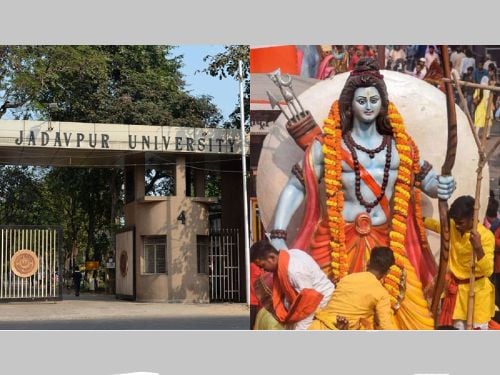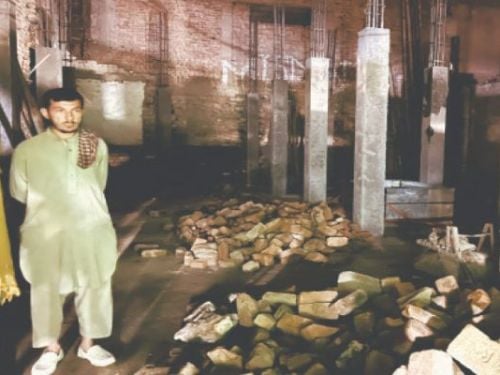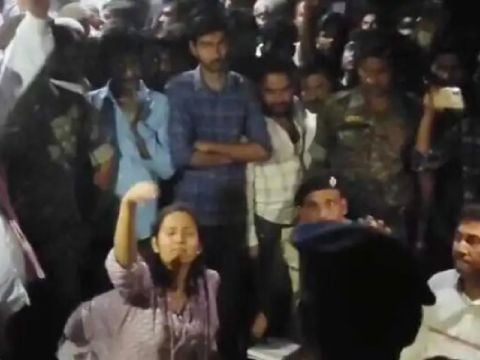
Located in Pakistan’s Punjab province, the Katas Raj Temple complex, also known as Qila Katas, houses several Hindu temples linked to one another by walkways. The Supreme Court of Pakistan called the Katas Raj a national heritage and said, “This temple is not just a place of cultural significance for the Hindu community, but also a part of our national heritage.” The temples are considered to be the second most sacred site for Hindus in Punjab.
The Katas site houses the Satgraha, a group of seven ancient temples, remains of a Buddhist stupa, five other medieval temples, havelis scattered around a pond considered holy by Hindus. The temples here are mostly constructed on square platforms. The elevation of the sub shrines seems to form a series of cornices with small rows of pillars, crowned by a ribbed dome. The seven temples were built in an architectural style similar to Kashmiri temples, with dentils, fluted pillars, trefoil arches, and rooflines that are pointed.
The complex surrounds a pond named Katas which is regarded as sacred by Hindus. The complex is located in the Potohar Plateau region of Pakistan’s Punjab province. The name Katas (Raj temple) is derived from Kataksha, a Sanskrit word meaning ‘tearful eyes’. According to legend, the pond was formed after lord Shiva wept upon the death of his wife Satti.
The temples play a role in the Hindu epic poem, the Mahabharata, where the temples are traditionally believed to have been the site where the Pandava brothers spent a significant portion of their exile. It is also traditionally believed by Hindus to be the site where the brothers engaged in a riddle contest with the Yakshas, as described in the Yaksha Prashna. Another tradition states that the Hindu deity Krishna laid the foundation of the temple, and established a hand-made shivling in it.
The site is believed to be a complex popular for its pilgrimage site for Hindus prior to the 1947 Partition. However, until the Indo-Pakistani War of 1965, the Indian pilgrims were barred from visiting again until 1984. The temples fell into disrepair over the decades and suffered neglect. Pakistani Hindus would continue to occasionally visit the site, but were unable to maintain the expansive complex. The pond was polluted with litter. Veteran leader Lal Krishna Advani had visited the temples in 2005 and expressed displeasure at the site’s dilapidated state.
In 2005 Pakistan proposed to restore the temple complex, while in 2006 the restoration project began in order to clean the sacred pond, paint and restore some temples, and installation of informational blue boards around the temple complex. 300 Indian Hindus visited the site for the Shivratri festival in 2006. 2,000 Pakistani Hindus resumed the tradition of celebrating Shivratri at the temple in 2010, and another 2,000 in 2011 with visitors coming from as far as Karachi. A wedding for Hindu couples was arranged during that year’s Shivratri festival for couples from Khyber Pakhtunkhwa province whose families had lost much of their property in the 2010 Pakistan floods.
In January 2017, Pakistan’s government began installation of shikharas on the temples. In February 2017, 200 pilgrims from India traveled to the temple to participate in the Katas Raj Dham festival. However, on November 23, Pakistan’s Supreme Court flayed the government for failing to protect the sacred pond in the historic Katas Raj temple complex revered by Hindus and ordered setting up of a high-level committee to probe the matter.
The sacred pond is receding as the underground aquifer feeding it is under stress due to industrial activity in the area. The issue was taken up by Chief Justice Saqib Nisar on the basis of media reports that the Katas Raj pond in Chakwal district of Punjab was drying up because cement factories nearby were drawing a large amount of water through a number of borewells, severely reducing the sub-soil water level.
Idols of Hindu gods were placed in the seven temples, at a cost of Rs 51.06 million. A three-member archaeological team visited India, Sri Lanka and Nepal to collect murtis of various Hindu gods.
Source : Indian Express

 Jadavpur Univ revokes permission to celebrate Ram Navami on campus after granting it
Jadavpur Univ revokes permission to celebrate Ram Navami on campus after granting it Andhra Pradesh: Farooq kills mentally challenged Hindu man for insurance money
Andhra Pradesh: Farooq kills mentally challenged Hindu man for insurance money Pakistan: Ancient Hindu temple in Khyber Pakhtunkhwa demolished for commercial complex
Pakistan: Ancient Hindu temple in Khyber Pakhtunkhwa demolished for commercial complex Bihar: Goddess Bhagavati Temple in Araria vandalised and deities damaged
Bihar: Goddess Bhagavati Temple in Araria vandalised and deities damaged Vadodara: Beef supplier Imran Qureshi arrested in beef-stuffed samosa case
Vadodara: Beef supplier Imran Qureshi arrested in beef-stuffed samosa case After Idukki diocese, Syro Malabar Catholic Church’s Thamarassery diocese screens ‘The Kerala Story’
After Idukki diocese, Syro Malabar Catholic Church’s Thamarassery diocese screens ‘The Kerala Story’